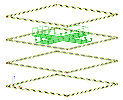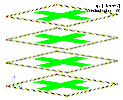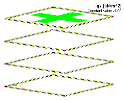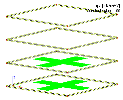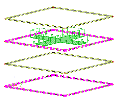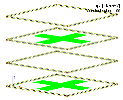Introduction to free loads
Free load is related to slabs. The load is not defined by the entity it acts on, but by a specific load border. Free loads are defined by means of "loading entities" that may overlap or affect one or more slabs.
Available types of "loading entity"
|
The loading entity is defined by means of a general polygon. |
|
|
line |
The loading entity is defined by means of a line or polyline. |
|
point |
The loading entity is defined by means of a point. |
Note: The loading entity may be oriented arbitrarily but can be input only in the XY plane of the current UCS. Therefore, before one can input the free load, it is necessary to adjust the working plane accordingly.
Each loading entity keeps a record of what was the orientation of the UCS when the entity was defined. The orientation of the UCS is important as some of the loading parameters may be related to this UCS. Whenever any already defined free load entity is selected, the appropriate UCS is activated.
If an inclined slab is subject to free load (the word inclined means that the plane of the slab and the loading plane of the loading entity are not parallel), the final load value is calculated from the projection of defined load onto the selected slab.
Free load is independent of finite element mesh and possible refinement or "coursing" of the mesh does not affect the calculated results.
It is possible to manually define which particular slabs should be subject to a particular free load. Alternatively, the program may automatically detect all affected slabs and apply the load on them. The former approach enables the user to extract specific slabs from the effect of the defined load.
Validity of free loads
The validity of free load means (i) which particular slabs are subject to the given load and (ii) the halfspace where the load acts (i.e. the direction of the load).
|
All |
Both entities located under and above the defined load are subject to the defined load. |
|
-Z |
If ON, the load is supposed to act only in the space located along the negative half of Z-axis of the User coordinate system. That means that ONLY the entities located UNDER the XY-plane of the UCS are subject to the load in question. |
|
-Z (incl. 0) |
The same as above plus entities located IN the XY-plane of the UCS. |
|
Z = 0 |
Only the entities located in the XY-plane of the UCS are subject to the load in question. |
|
+Z |
If ON, the load is supposed to act only in the space located along the positive half of Z-axis of the User coordinate system. That means that ONLY the entities located ABOVE the XY-plane of the UCS are subject to the load in question. |
|
+Z (incl. 0) |
The same as above plus entities located IN the XY-plane of the UCS. |
|
Selected |
The user must define which particular entities are supposed to be subject to the given load. |
The validity parameters can become more clear from the following example.
Let’s have four slabs input one above the other. Define free area load in the plane of the third slab (from the bottom).
First, set option Select to All and validity to All. Perform the calculation and open function Calculation, mesh > 2D data viewer > Surface load. You can see that the load acts on all four slabs.
Second, set option Select to All and validity to Z. The load acts only on the top slab because it acts only on that part of the structure that is above the plane in which the load is defined. (If the load was input let’s say 5 cm below the midplane of the third (from bottom) slab, also that slab would be subject to the load.)
Third, set option Select to All and validity to –Z. The load acts only on two bottom slabs because it acts only on that part of the structure that is below the plane in which the load is defined.
Fourth, set option Select to Select and validity to All. Select the most bottom slab and the third one.
The load acts only on the two selected slabs only.
Note: Attention must be paid to the situation when parameter Select is set to Select and parameter Validity is set to Z or –Z. In this case the two conditions are combined to make a product. So it could happen that there is no slab that would comply with both the conditions: being selected and being in the proper semi-space.
Note: The loads generated from a defined free load can be neither moved nor copied. Functions Move AddData and Copy AddData are disabled for them.

